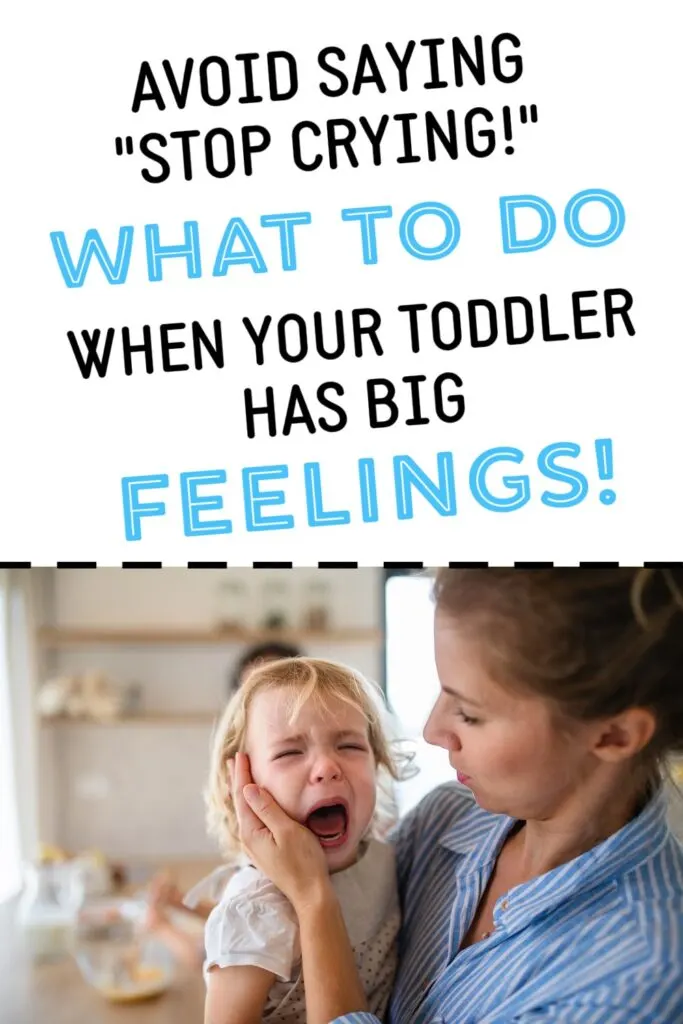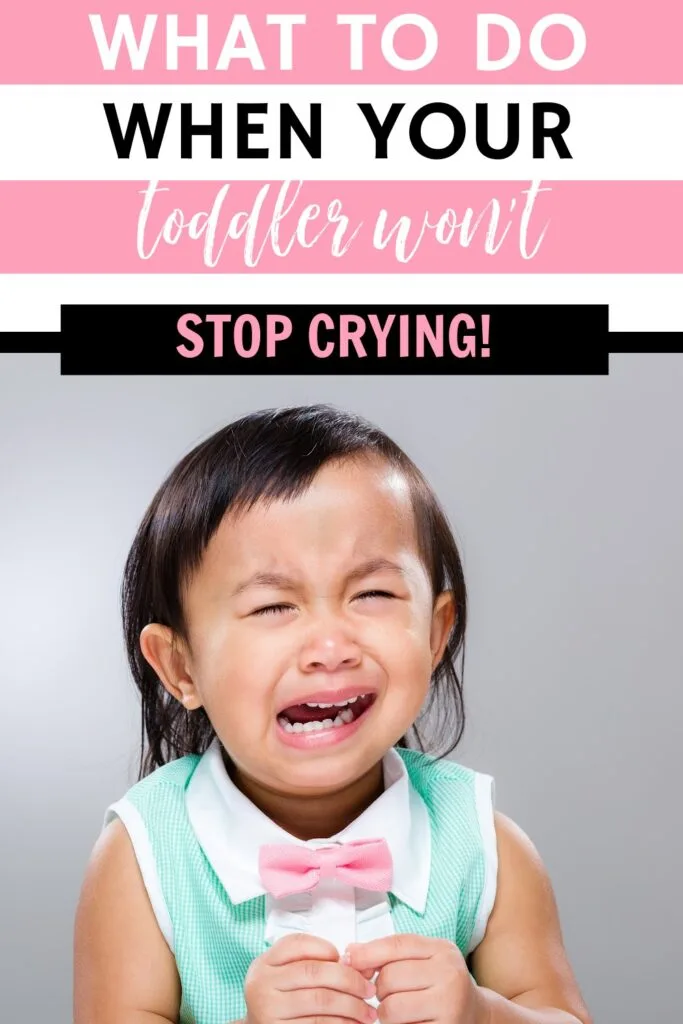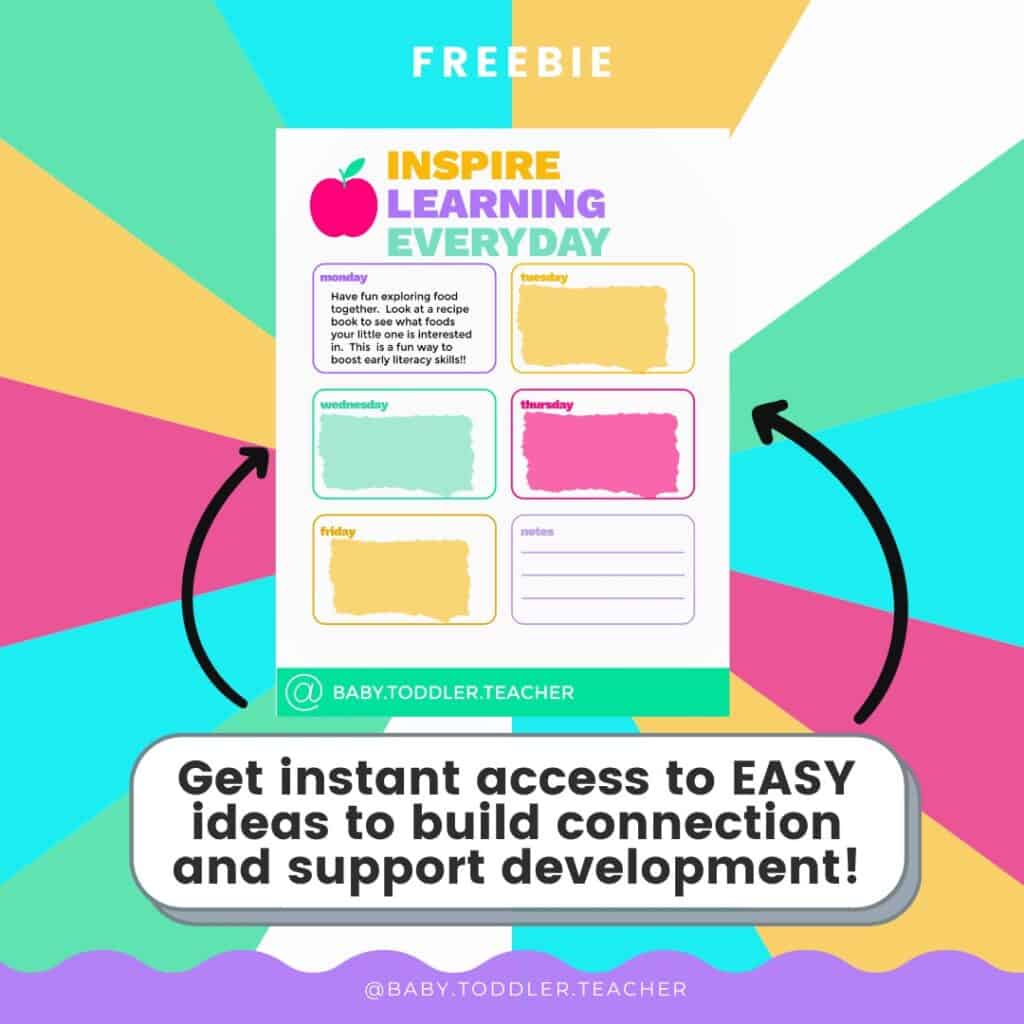Toddler Won’t Stop Crying!
Facing a crying toddler can feel like one of the most daunting challenges for parents, especially when the tears seem non-stop.
It’s an all too common scenario: a young child is overcome by big feelings and expresses them in the only way they know how – through crying.
The good news is, this is normal behavior.
Toddlers, or young kids, are still learning how to express their emotions and navigate the world around them.
In this blog post, we will explore the different ways to comfort a crying toddler and help them better express their feelings.

(This post may contain affiliate links. To read our full disclosure policy click here.)
Crying is Communication
The first thing to understand is that a crying child is not a sign of a bad parent, but an effective way for toddlers to communicate.
Since they cannot always use words to express their own emotions or needs, crying becomes their primary mode of communication.
This can occur for a variety of reasons. It may be due to physical needs such as hunger, tiredness, or discomfort.
It could also be related to emotional expression such as frustration over little disappointments or separation anxiety.
Skipping a daytime nap or encountering different situations that they do not understand can also lead to crying.
In such instances, the best thing a parent or caregiver can do is to stay calm and try to identify the child’s needs.
Remembering that crying is a normal part of toddlerhood may help to alleviate some of the stress associated with a crying toddler.
It’s important to approach each situation with understanding and patience, as this will significantly influence how effectively you can comfort and respond to the child’s needs.

Pay Attention to Changes in Crying Patterns
From my personal experience as a parent, I’ve learned that a sudden increase in the frequency or intensity of my child’s crying can be an early indication of illness.
Children, particularly toddlers, may not be able to articulate that they’re feeling unwell, and a change in their usual crying can be one of their only ways to communicate this.
In such situations, it’s crucial to be mindful of these changes and take proactive steps to assess their health.
A swift check of their temperature can be an effective way to identify if a fever is causing distress.
A fever, even a mild one, can make toddlers feel miserable, leading to more tears than usual.
Additionally, asking simple questions about how they’re feeling can also help.
They might not be able to tell you in exact terms what’s wrong, but their responses could still provide some valuable clues.
For example, holding their ear might indicate an ear infection, or saying their tummy hurts could signal a stomach bug.
Promptly recognizing these signs and subsequently seeking medical advice can ensure your child gets the necessary care swiftly, potentially averting more serious complications.
Don’t Ignore A Crying Child, Be Supportive
Ignoring a crying child isn’t the solution; in fact, it often exacerbates the issue.
When a toddler cries, it’s a call for attention, a plea for a response.
By ignoring them, we’re failing to provide the support and reassurance they need.
Remember, children at this age are still making sense of their feelings and their environment.
When your child cries, instead of dismissing it as unnecessary noise, consider it as a key to understanding their needs. Is your child hungry or tired?
Are they feeling unwell or uncomfortable?
Or do they simply need a hug?
Patience and empathy in these moments can go a long way.
It’s vital to acknowledge their feelings and reassure them that it’s okay to express themselves.
Responding to them and providing comfort shows that you’re there for them, leading to a sense of security and trust.
It’s an important part of nurturing emotional literacy in children, teaching them how to handle their emotions, and building a strong parent-child relationship.
So, next time your toddler is crying, instead of turning away, lean in, listen and offer your supportive presence.

Offer Support
Offering support to your child when they are crying or upset is crucial.
Recognize that your toddler is having a hard time, and their feelings are just as valid and important as anyone else’s.
One of the best ways to offer support is by encouraging them to take deep breaths.
This can help them calm down and can also be a useful technique to distract them from what they’re upset about.
Younger children can often find it difficult to understand why they’re feeling certain emotions, so it’s important to help them process their feelings.
Show empathy by acknowledging their feelings – say something like, “I understand that you’re upset because you can’t have the toy you want. It’s a big deal for you.”
This helps them feel understood and reassures them that their feelings are important.
A comfort item, such as a favorite toy or blanket, can also be a great help.
Having a familiar item can provide a sense of security and help soothe them.
Always remember, that respecting and responding to your child’s feelings in these situations is the key to helping them navigate through their emotions.
Teaching Emotional Regulation Skills
Teaching emotional regulation skills in the early years is critically important in helping children manage their big emotions effectively.
When a toddler is facing a temper tantrum, understanding and controlling their emotional reactions is key.
Although temper tantrums are developmentally appropriate we can still introduce these skills to help avoid some of them.
As parents or caregivers, modeling emotional regulation is a good idea.
This means showing them how to cope with stress or frustration in healthy ways.
For instance, demonstrate deep breathing when you’re annoyed or upset, so they can mimic this behavior when they feel overwhelmed.
Such stories help children understand that they are not alone in dealing with their emotions and teach them practical ways to handle their feelings.
Incorporating emotional regulation skills into play is another effective method.
Role-playing games allow children to practice expressing their emotions and responding to the emotions of others in a secure and low-stakes environment.
Remember, reassurances during moments of stress, such as when dealing with a screaming toddler, can work wonders in helping them regain control.
Consistent reassurances like “it’s okay to feel upset” or “you’re safe, even when you’re angry” helps them understand that emotions are a normal part of life, and it’s all about how we manage them.
Lastly, fostering self-control in a child is an integral part of teaching emotional regulation.
This involves teaching them that emotions, although intense, are temporary and manageable.
With time and consistent teaching, your child will become better equipped to handle their big emotions, transforming the daunting challenge of a crying toddler into a more manageable situation.
Self-Care for Caregivers
Caring for a child who cries frequently can be emotionally draining and very hard work.
It’s important to remember that while you’re providing empathetic care for your child, you also need to attend to your personal well-being.
Stress and fatigue can lead to burnout, making it challenging to provide effective care and emotional support.
Make sure to take regular breaks, even short ones, to relax and recharge.
Engage in activities that invigorate you, whether that’s reading a book, going for a walk, or enjoying a quiet cup of tea.
Moreover, don’t hesitate to ask for help when needed. Rely on your support network— family, friends, or professional caregivers who can step in to provide temporary relief.
Remember, seeking assistance is not a sign of weakness but an act of self-care.
It’s crucial to maintain a healthy state of mind and body to continue providing the best care for your child. It’s perfectly okay to acknowledge when it gets tough and to seek support to regain your balance.
Balancing self-care with caregiving responsibilities is not merely desirable, but essential.
Hang in there!
The journey of navigating through your young child’s tears can at times feel like a daunting task.
However, with understanding and patience, it’s possible to help the crying stop.
Toddlers use crying as an important mode of communication.
It’s essential to realize that they might be crying due to a possible reason such as hunger, tiredness, frustration, or simply because they are overwhelmed by big feelings they don’t yet fully understand.
Taking appropriate steps such as offering support, empathizing with their situation, and providing comfort items can significantly help in appeasing your child’s tears.
However, it’s also crucial to remember that they might still need help in understanding and expressing their emotions.
Teaching emotional regulation skills is indispensable in this regard.
Reading relevant books, incorporating emotional regulation into play, and demonstrating healthy ways to cope with stress and frustration are different approaches to help your child handle their emotions.
Self-control is a pivotal skill that children need to learn to manage their emotions effectively.
Handling a difficult situation involving a crying toddler can be stressful, yet remember, with a little patience and understanding, it can be turned into a more manageable and less overwhelming experience.

Grab your FREE Milestone Guide HERE.
Frequently Asked Questions
Toddlers often cry as it’s their primary way of expressing themselves and communicating their needs. They might cry due to a variety of reasons, such as hunger, fatigue, discomfort, or frustration. They could also be crying because they’re overwhelmed by big feelings they don’t yet fully understand. Emotional triggers such as changes in their environment or routine can also result in increased crying. Remember, toddlers are still learning how to regulate their emotions, so crying can be a normal response during this developmental stage.
Comforting a crying toddler involves a combination of emotional understanding and tangible action. First, approach your toddler with empathy and acknowledge their feelings. Say something like, “I can see you’re upset,” to show understanding. Next, try to identify the cause of the distress. If it’s something simple like hunger or tiredness, addressing the need can often stop the crying. If the toddler is overwhelmed by emotions, you may need to help them calm down. This can involve physical reassurance, such as a hug, or distraction techniques like reading a book or playing a game. If the reason for the crying is not immediately apparent, be patient and provide a comforting presence until the tears subside. Remember, it’s always important to stay calm and composed when dealing with a crying toddler. Your calmness can help soothe them and provide a sense of security.
Teaching emotional regulation to toddlers can be accomplished through a variety of effective strategies. Start by modeling appropriate emotional responses yourself. Toddlers learn a great deal from observing the adults around them. Show them how you effectively handle your emotions during different situations. Another method is through play. Incorporate activities that require taking turns, which can teach them patience and self-control. Reading books that illustrate characters dealing with various emotions can also be helpful. Discuss these stories and the characters’ emotional responses with your toddler. Regularly engage in conversations about emotions, helping your toddler to identify and name their feelings. Over time, this can help them understand that all emotions are normal and manageable. Additionally, teaching relaxation techniques like deep breathing or guided imagery can be beneficial in calming a toddler when they feel overwhelmed. Lastly, always be patient and understanding, reinforcing that it’s okay to feel emotions and offering comfort and guidance as they navigate through them.
Managing your stress while dealing with a crying toddler can indeed be challenging, but it’s crucial for both your well-being and that of your child. Firstly, practice self-care whenever possible. This includes ensuring you get adequate sleep, eat healthily, and engage in regular physical activity. Each of these factors can significantly influence your stress levels and overall mood. Secondly, mindfulness exercises such as deep breathing, meditation, or yoga can help reduce stress and promote a sense of calm. Take a few moments to step away and regroup if you’re feeling overwhelmed. Thirdly, don’t hesitate to seek support. This could be in the form of family, friends, or a professional counselor. Sharing your experiences and feelings with others can provide a sense of relief and perspective. Finally, remember that it’s okay to take breaks. If your child is safe and you are feeling stressed, it’s perfectly acceptable to give yourself a “timeout” to collect your thoughts and emotions. Above all, be patient with yourself – parenting is a tough job and it’s perfectly normal to feel stressed at times.
Related Posts You Will Enjoy
Potty Training Regression: Why it Happens and what to do
End Bedtime Battles: Printable Bedtime Checklist
Easy and Fun Early Literacy Activities for Toddlers
The Best 1-Year-Old Sensory Activities
How to Teach a Toddler to Talk


Kayla O’Neill has a master’s degree in education as well as a bachelor’s degree in special education with an emphasis in early childhood education. She has been working as a developmental therapist with babies and toddlers in early intervention since 2012. She is also a mom with two young children.
